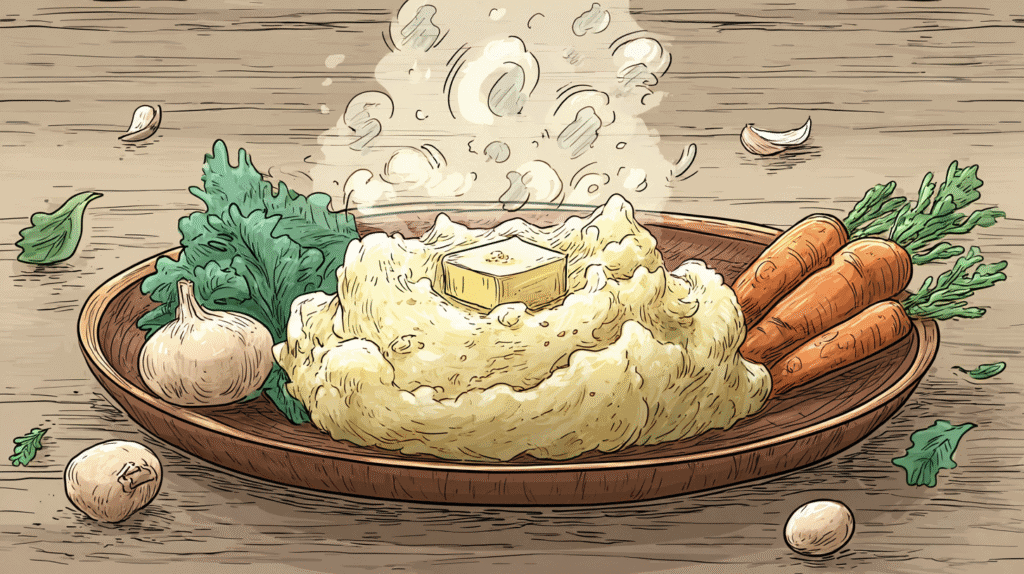Table of Contents
Are Instant Mashed Potatoes Okay for Diabetics? Understanding Their Impact on Blood Sugar
If you have diabetes, you might be asking yourself if instant mashed potatoes belong in your diet. Instant mashed potatoes have a high glycemic index, so they can make your blood sugar jump up fast—definitely something to watch out for.
Sure, instant mashed potatoes offer a few vitamins and minerals. But their speedy effect on blood sugar can be risky if you don’t pay attention to portions or what you eat them with.
You don’t have to cut them out entirely, but a little planning goes a long way.
Key Takeaways
- Instant mashed potatoes can spike blood sugar quickly because of their high glycemic index.
- They do have some nutritional perks, but moderation is key if you’re diabetic.
- Pairing them with other foods and watching your portion size can help soften their impact.
How Instant Mashed Potatoes Affect Blood Sugar
Instant mashed potatoes pack a lot of carbs and have a high glycemic index. That combo can send your blood sugar climbing fast.

Carbohydrates and Glycemic Index
These potatoes are pretty much all carbs. Your body breaks them down into sugars, which hit your bloodstream in a hurry.
The glycemic index (GI) for instant mashed potatoes sits at about 87. That’s high—kind of like drinking a sugary soda.
Impact on Blood Glucose Levels
Because of this high GI, instant mashed potatoes can trigger sudden jumps in your blood sugar after a meal. Sometimes you’ll even feel that energy crash not long after.
Eating a big pile of instant mashed potatoes can push your blood sugar higher than you’d like. If you’re not careful, this can make managing diabetes tougher.
Balancing your plate with some protein or fiber can help.
Role of Resistant Starch in Slow Digestion
Resistant starch is a carb your body doesn’t digest right away. Some potatoes have it, which means slower sugar absorption.
Instant mashed potatoes, though, lose most of their resistant starch during processing. That means they digest fast, and your blood sugar rises quickly.
Pairing them with high-fiber foods might help, but honestly, there’s not much resistant starch left in the instant stuff.
Nutritional Profile and Health Considerations
Instant mashed potatoes aren’t all bad—they have some nutrients. But for folks watching blood sugar, there are a few things to keep in mind.
Vitamins, Minerals, and Fiber Content
You’ll get a bit of potassium and vitamin C from instant mashed potatoes. Not a ton, but it’s there.
Their fiber content is pretty low, especially compared to whole potatoes. That’s not ideal, since fiber helps slow down blood sugar spikes.
If you’re looking for something to help manage diabetes, higher-fiber foods might be a better bet.
Fat and Protein Balance
There’s not much fat or protein in instant mashed potatoes. That means your meal might digest faster, causing your blood sugar to rise quicker than you’d like.
Adding some lean protein or a bit of healthy fat—maybe chicken or a drizzle of olive oil—can help slow things down.
A little balance goes a long way.
Processed Food Concerns
Instant mashed potatoes are definitely processed. Processing strips away some vitamins and most of the natural fiber.
They end up with a high glycemic index—again, that’s about 87. That’s higher than boiled or baked potatoes.
So, if you’re eating instant mashed potatoes, it’s smart to keep an eye on portions and pair them with lower-GI foods.
Practical Tips for Including Instant Mashed Potatoes in a Diabetic Diet
You don’t have to give up instant mashed potatoes completely. With a little strategy, you can work them in.
Portion Control and Moderation
Portion size is huge here. Since instant mashed potatoes have a high GI, eating a lot at once can spike your blood sugar.
Try to keep your serving to about half a cup or even less, especially if you eat them often. Smaller portions help prevent overeating and weight gain.
Using a smaller bowl can make it easier. It’s tempting to go back for seconds, but moderation really does matter.
Combining with Beans and Legumes
Adding beans or legumes to your meal can slow digestion of the starch in instant mashed potatoes.
Beans are packed with fiber and protein, which keep you full and help manage hunger.
Try tossing some lentils or black beans into the mix, or just serve them alongside. It’s a tasty way to balance things out.
Alternative Cooking Methods for Low GI
How you cook potatoes changes their glycemic index. Instant mashed potatoes are quick, but their GI is high.
If you have the time, try boiling fresh potatoes and cooling them before eating. That ups the resistant starch and slows digestion.
Skip frying or baking at high temps—those methods can boost the GI even more. Fresh, cooled potatoes are a better bet for steady blood sugar than the instant kind.
Meal Planning Strategies
Try to work instant mashed potatoes into your meal plans with a bit of care. Pair them up with low-GI veggies, lean proteins, or a splash of healthy fats for a more balanced plate.
Don’t let instant mashed potatoes become your main carb every single day. Mix things up—swap in whole grains or other starchy veggies here and there to keep your blood sugar from bouncing around.
If you’re up for it, track what you eat to catch any patterns, like overeating or weird blood sugar swings. Jotting things down in a food journal or using an app can really help, though honestly, it’s not everyone’s favorite habit.